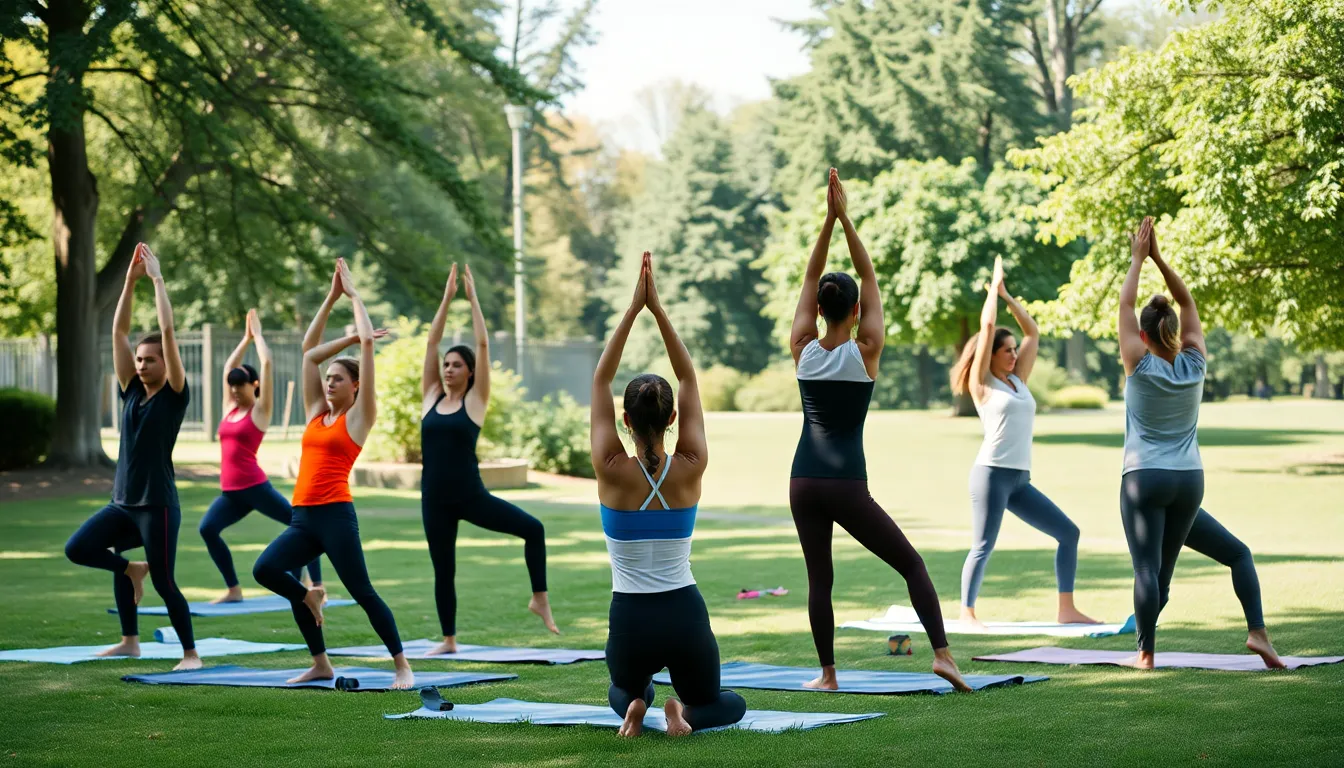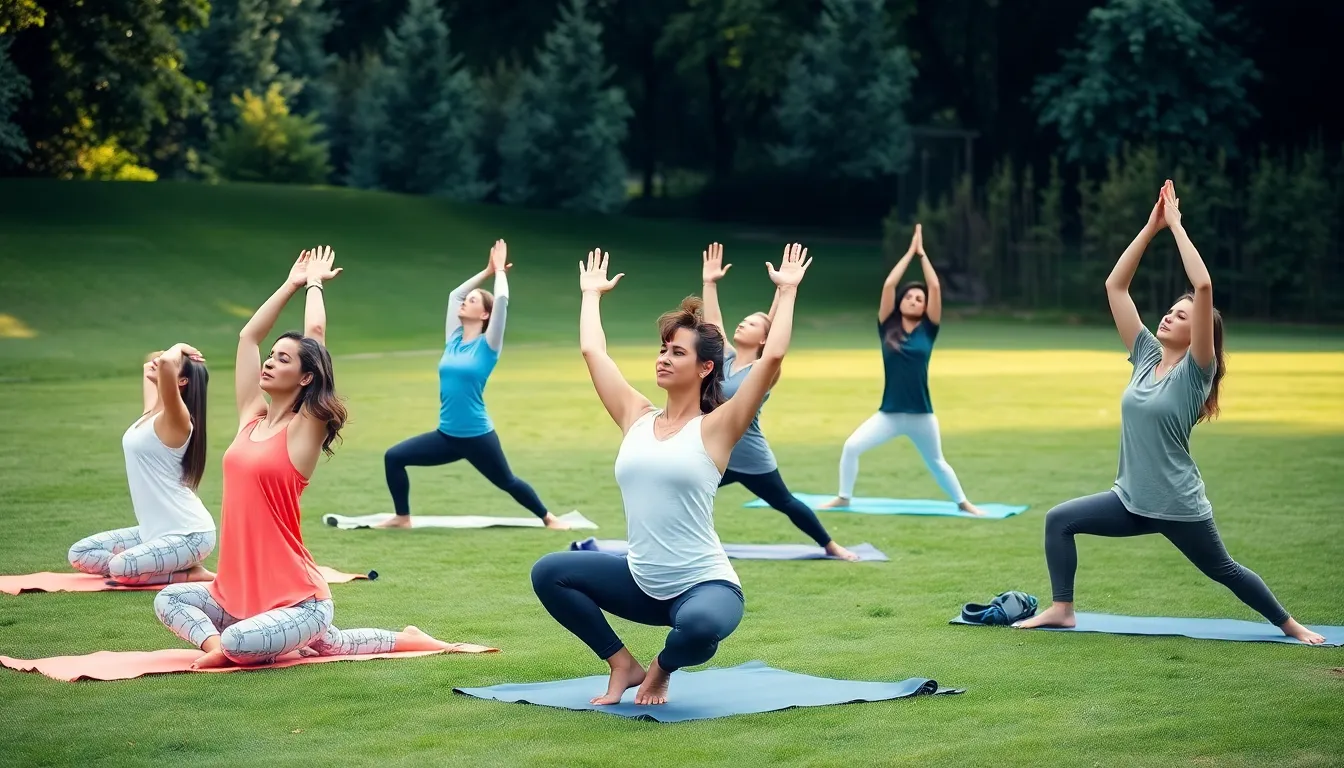Yoga exercises have gained immense popularity as a holistic approach to wellness, blending physical movement with mental clarity. With its roots in ancient traditions, yoga offers a versatile practice that caters to people of all ages and fitness levels. Whether someone seeks to enhance flexibility, build strength, or reduce stress, yoga provides a pathway to achieving these goals.
Incorporating yoga into daily routines can lead to numerous benefits, from improved posture to increased mindfulness. With a variety of styles and techniques available, individuals can easily find the right practice that resonates with their personal needs. This article explores essential yoga exercises, guiding readers toward a more balanced and fulfilling lifestyle.
Table of Contents
ToggleOverview of Yoga Exercises
Yoga exercises encompass a variety of postures, breathing techniques, and meditative practices aimed at improving physical and mental well-being. Each exercise targets specific aspects of health, facilitating benefits such as increased flexibility, enhanced strength, and mental clarity.
Types of Yoga Exercises
- Asanas: Asanas are physical postures constituting the core of yoga practices. Examples include:
- Downward Dog
- Warrior Poses
- Tree Pose
- Pranayama: Pranayama involves breath control techniques that promote relaxation. Common techniques include:
- Ujjayi Breathing
- Alternate Nostril Breathing
- Kapalabhati Breathing
- Meditation: Meditation complements physical postures by fostering mental clarity and focus. Methods often practiced include:
- Mindfulness Meditation
- Guided Visualization
- Loving-kindness Meditation
Benefits of Yoga Exercises
- Physical Strength: Many poses strengthen muscles, supporting joint health and stability.
- Flexibility: Regular practice increases overall flexibility, reducing the risk of injury.
- Stress Reduction: Breathing exercises and meditation techniques reduce stress levels, promoting a sense of calm.
Incorporating Yoga into Daily Life
Integrating yoga exercises into daily routines enhances overall quality of life. Practicing for as little as 10 minutes each day leads to significant improvements in mood and energy levels. Individuals can choose between in-person classes, online sessions, or self-guided practices to suit their preferences and schedules.
Benefits of Yoga Exercises

Yoga exercises provide numerous benefits that enhance both physical and mental well-being. By integrating these practices into daily routines, individuals experience significant improvements in various aspects of their health.
Physical Benefits
- Increased Flexibility: Yoga postures stretch muscles and improve joint mobility. Regular practice leads to a noticeable range in motion, enabling better performance in daily activities and other physical exercises.
- Improved Strength: Many yoga poses require practitioners to support their body weight in different ways. This builds core strength, enhances muscle tone, and improves overall stability.
- Enhanced Posture: Yoga promotes awareness of body alignment. Strengthening core and back muscles helps maintain proper posture, reducing the risk of pain and injury.
- Better Balance: Balancing poses in yoga enhance stability and coordination. Improved balance reduces the likelihood of falls, especially in older adults.
- Cardiovascular Health: Certain styles of yoga, such as Vinyasa or Power Yoga, provide cardiovascular benefits. Increased heart rate during flow sequences fosters better circulation and heart health.
Mental Benefits
- Reduced Stress: Yoga practices incorporate mindfulness and breath control, which lower stress levels. Regular practitioners report a significant decrease in cortisol, the stress hormone.
- Enhanced Focus: Meditation and concentration techniques in yoga improve mental clarity and focus. This boosts productivity and sharpens cognitive function.
- Increased Mindfulness: Practicing yoga encourages present-moment awareness. Mindfulness promotes emotional regulation and enhances overall mental wellness.
- Emotional Balance: Yoga fosters emotional awareness and resilience. Many practitioners experience an improvement in mood and reduced symptoms of anxiety or depression.
- Better Sleep: Consistent yoga practice aids in relaxation and stress reduction, leading to improved sleep quality. Restorative styles of yoga are particularly effective for enhancing restful sleep.
Types of Yoga Exercises
Yoga includes several styles, each with unique characteristics and benefits. Understanding these styles helps individuals choose the right practice for their goals.
Hatha Yoga
Hatha Yoga serves as the foundation for many yoga styles. It emphasizes physical postures and breathing techniques to promote relaxation and strength. Practicing Hatha Yoga typically involves slow-paced routines, allowing practitioners to focus on alignment and breath control. Beginners often find Hatha Yoga accessible due to its straightforward approach, and it enhances both flexibility and mental clarity.
Vinyasa Yoga
Vinyasa Yoga features a dynamic flow of postures synchronizing with breath. This style incorporates a series of movements linked together, creating a continuous flow that builds strength and endurance. Vinyasa classes can vary in pace, accommodating practitioners of all levels. This type of yoga encourages creativity in sequencing, making each session unique while enhancing cardiovascular health and focus.
Ashtanga Yoga
Ashtanga Yoga follows a set sequence of postures performed in a specific order. This rigorous practice emphasizes strength, flexibility, and internal energy control through breath (Ujjayi breathing). Generally divided into six series, Ashtanga challenges practitioners at all levels, with a strong focus on building discipline and endurance. Regular practice of Ashtanga promotes overall fitness, stamina, and increased mental focus.
Beginner Yoga Exercises
Beginner yoga exercises offer an accessible way to explore the foundations of yoga practice. These exercises cultivate strength, flexibility, and mindfulness, allowing new practitioners to establish a solid base.
Basic Poses for Beginners
- Downward Dog
Downward Dog stretches the spine and strengthens the arms and legs. It promotes overall body alignment while encouraging deep breathing.
- Child’s Pose
Child’s Pose provides a gentle stretch for the back and hips. It encourages relaxation and offers a moment of stillness during practice.
- Warrior I
Warrior I builds strength in the legs and core. It enhances balance and stability while promoting confidence and focus.
- Mountain Pose
Mountain Pose establishes a strong foundation for standing postures. It improves posture and body awareness, which are crucial for effective practice.
- Cat-Cow Stretch
The Cat-Cow Stretch enhances spinal flexibility and mobility. It prepares the body for more advanced poses by warming up the muscles.
Tips for Practicing
- Focus on Breathing
Emphasizing breath during each pose aligns the mind and body. It enhances relaxation and aids in transitioning between poses.
- Listen to the Body
Paying attention to body signals helps prevent injury. Practitioners should respect their limits while gradually exploring new challenges.
- Use Props
Incorporating props like blocks and straps provides support. Props help achieve proper alignment, making poses more accessible to beginners.
- Practice Regularly
Establishing a consistent practice schedule promotes gradual improvement. Even short sessions can yield significant benefits over time.
- Join a Class
Participating in beginner classes offers guided instruction. Instruction from qualified teachers helps refine techniques and enhances the overall experience.
Advanced Yoga Exercises
Advanced yoga exercises include poses that challenge strength, flexibility, and balance. Practitioners benefit from mastering these exercises, which deepen their practice and enhance overall well-being.
Challenging Poses
Challenging poses provide significant physical and mental growth for advanced practitioners. Key examples include:
- Handstand (Adho Mukha Vrksasana): Balances on hands, building arm strength and core stability.
- Scorpion Pose (Vrschikasana): Involves a backbend while balancing on the forearms, enhancing flexibility and strength.
- Eagle Pose (Garudasana): A standing pose that increases balance, focus, and strength in the legs and core.
- King Pigeon Pose (Rajakapotasana): A deep backbend and hip opener that stretches the entire front body while enhancing flexibility.
- Crow Pose (Bakasana): This arm balance builds upper body strength, encouraging focus and confidence.
Each pose develops physical skills while fostering mental clarity and perseverance. Practitioners should maintain proper alignment to prevent injury.
Incorporating Props
Incorporating props into advanced yoga exercises enhances stability and alignment. Common props include:
- Blocks: Used in poses like Triangle Pose (Trikonasana) to increase reach and support alignment.
- Straps: Aid in deepening stretches, especially in poses like Bound Angle Pose (Baddha Konasana) for increased flexibility.
- Bolsters: Provide support in restorative poses, allowing deeper relaxation and improved posture.
- Wall: Acts as a stabilizing element for poses such as Handstand, allowing practitioners to build confidence in their balance.
Using props encourages practitioners to explore their limits safely. They facilitate modified versions of difficult poses, ensuring a sustainable advancement in practice.
Yoga exercises offer a pathway to improved physical and mental well-being. By embracing various styles and practices individuals can tailor their yoga journey to meet personal goals and preferences. Whether through foundational poses or advanced challenges each practice contributes to greater flexibility strength and mindfulness.
Incorporating yoga into daily routines fosters not only a balanced lifestyle but also enhances emotional resilience and overall health. With options ranging from in-person classes to self-guided sessions everyone can find a way to integrate yoga into their lives. By committing to this holistic practice individuals can unlock a deeper sense of clarity and fulfillment.




